Bricks, Beads & Bones Class 12 History
Introduction
- The Harappan seal is a significant artifact of the Harappan or Indus Valley civilization.
- It is made of a stone called steatite and often features animal motifs and undeciphered script.
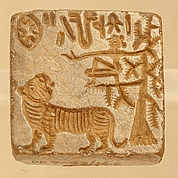 Harappan Seal
Harappan Seal
- We have a wealth of knowledge about the lives of the people in the region through the archaeological evidence they left behind.
- This evidence includes their houses, pots, ornaments, tools, and seals.
- The Harappan civilization is well-studied through the interpretation of archaeological material. Interpretations of this material can change over time.
- There are still unknown aspects of the civilization that may never be fully understood.
- The term Harappa comes from the site where this civilization was first identified. Its timeline spans from 6000 BCE to 1300 BCE.
1. Early Harappan (6000 BCE-2600 BCE): Formative phase.
2. Mature Harappan (2600 BCE-1900 BCE): Prosperous urban phase.
3. Late Harappan (1900 BCE-1300 BCE): Decline phase. Harappan artifacts include pottery, bricks (both baked and unbaked), seals, weights, beads, and copper and bronze items. These have been found across regions from Afghanistan to Maharashtra, including areas in Pakistan and India.
Beginnings
- Before the Mature Harappan period, there were multiple archaeological cultures in the region.
- These cultures had their own unique pottery styles, evidence of agriculture and animal herding, and some crafts.
- The settlements associated with these cultures were generally small in size.
- Interestingly, there were very few large buildings in these settlements.
- There seems to have been a significant break or discontinuity between the Early Harappan and Harappan civilization.
- This break is evident from the discovery of large-scale burning at some archaeological sites and the abandonment of certain settlements.
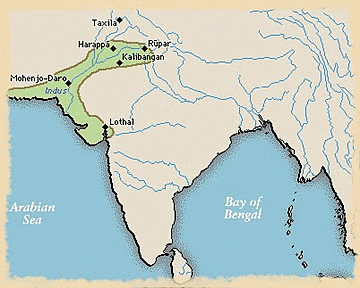
Subsistence Strategies
- The Mature Harappan culture developed in areas previously occupied by Early Harappan cultures.
- The Iliese cultures also shared certain elements with the Harappans, including subsistence strategies.
- The Harappans had a diverse diet, including a wide range of plant and animal products.
- Archaeo-botanists study charred grains and seeds to reconstruct the Harappan diet.
- Grains found at Harappan sites include wheat, barley, lentil, chickpea, sesame, and millets.
- Rice is relatively rare in Harappan sites.
- Animal bones found at Harappan sites indicate domesticated animals such as cattle, sheep, goat, buffalo, and pig.
- Bones of wild species like boar, deer, and gharial are also found, but it is unclear whether the Harappans hunted these animals or obtained meat from other hunting communities.
- Bones of fish and fowl are also found at Harappan sites.
Agricultural Technologies
- The prevalence of agriculture is indicated by the discovery of grain.
- It is difficult to reconstruct specific agricultural practices.
- Seals and terracotta sculptures suggest the use of oxen for ploughing.
- Terracotta models of ploughs have been found at Cholistan and Banawali.
- Evidence of a ploughed field with two sets of furrows has been found at Kalibangan.
- The Harappans may have used stone or metal tools for harvesting.
- Irrigation was likely necessary for agriculture in semi-arid areas.
- Traces of canals have been found at Shortughai, but not in Punjab or Sind.
- Ancient canals may have silted up, and wells may have been used for irrigation.
- Water reservoirs in Dholavira may have been used for storing water for agriculture.
Mohenjodaro: A Planned Urban Centre
- The Harappan civilization developed unique urban centers, with Mohenjodaro being one of the most well-known sites.
- The settlement of Mohenjodaro is divided into two sections:
- The Citadel is smaller and higher, with buildings constructed on mud brick platforms and surrounded by walls.
- The Lower Town is also walled and has buildings built on platforms.
- It required a large-scale mobilization of labor to construct the foundations for the platforms.
- Once the platforms were in place, building activity was restricted to a fixed area on the platforms, suggesting careful planning.
- Standardized bricks were used in construction, with a specific ratio of length, breadth, and height, seen throughout Harappan settlements.
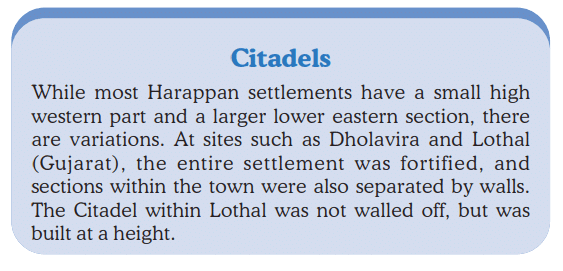 Citadels in Harappan settlements
Citadels in Harappan settlements
Laying out Drains
- Harappan cities had a well-designed drainage system.
- The Lower Town had roads and streets laid out in a grid pattern.
- Streets with drains were constructed first, followed by houses.
- Each house needed to have a wall along a street for waste water to flow into the drains.
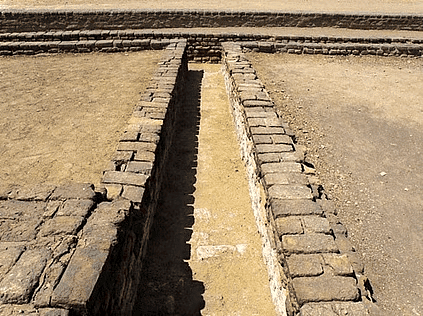 Drainage System
Drainage System
Domestic Architecture
- The Lower Town at Mohenjodaro had residential buildings centered around courtyards.
- The courtyards were likely used for cooking and weaving, especially during hot and dry weather.
- Privacy was important, as there were no windows on the ground level walls and the main entrance did not provide a view of the interior or courtyard.
- Each house had a bathroom paved with bricks, with drains connected to street drains.
- Some houses had stairs leading to a second storey or the roof.
- Many houses had wells, with an estimated total of 700 wells in Mohenjodaro.
The Citadel
- The Citadel contains structures used for special public purposes.
- These structures include a warehouse and the Great Bath.
- The Great Bath was a large rectangular tank surrounded by a corridor.
- It had steps on the north and south sides and was watertight with bricks and gypsum mortar.
- There were rooms on three sides, one of which had a large well.
- Water from the tank flowed into a drain.
- A smaller building with eight bathrooms was located nearby, with drains connecting to a main corridor drain.
- Scholars suggest that the unique structure and its location in the Citadel indicate it was used for a special ritual bath.
Tracking Social Differences
Burials
- Archaeologists use various strategies to determine social or economic differences within a culture.
- Burials are often studied to gather information about the society.
- In the Harappan civilization, burials were generally done in pits, with some variations in how they were constructed.
- Some pits were lined with bricks, possibly indicating social differences.
- Pottery and ornaments were sometimes placed in graves, possibly suggesting a belief in their use in the afterlife.
- Jewellery has been found in both male and female burials.
- Copper mirrors were occasionally buried with the dead, but the Harappans generally did not bury precious items with them.
Looking for "luxuries"
- Archaeologists use artefacts to identify social differences.
- Artefacts are classified as utilitarian (daily use objects) or luxuries.
- Utilitarian objects are made from ordinary materials and found throughout settlements.
- Luxuries are rare, made from costly or non-local materials, or have complicated technologies.
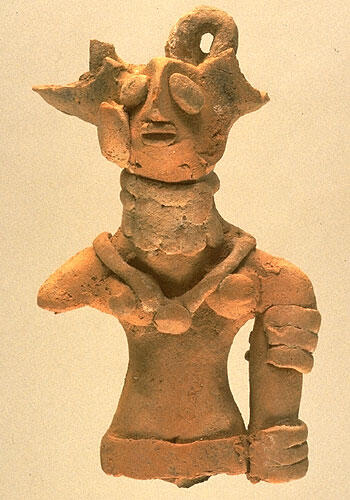 Luxuries
Luxuries
- Objects like faience pots were considered precious and difficult to make.
- Spindle whorls made of rare materials like faience pose a classification dilemma.
- Rare and valuable objects are concentrated in larger settlements like Mohenjodaro and Harappa.
- Miniature pots of faience and gold jewellery are found mostly in Mohenjodaro and Harappa, not in smaller settlements like Kalibangan.
- Gold jewellery was recovered from hoards, indicating its rarity and preciousness.
Finding Out About Craft Production
- Chanhudaro is a small settlement primarily focused on craft production.
- Craft production includes bead-making, shell-cutting, metal-working, seal-making, and weight-making.
- Various materials like stones, metals, shells, faience, and terracotta were used to make beads.
- Beads were made in different shapes and decorated with incising, painting, or etching.
- Techniques for making beads varied depending on the material used.
- The process of making steatite micro beads is still a mystery to archaeologists.
- The red color of carnelian beads was obtained through firing and various stages of production.
- Specialized drills were found at Chanhudaro, Lothal, and Dholavira.
- Nageshwar and Balakot, located near the coast, were specialized centers for making shell objects.
- Finished products from Chanhudaro and Lothal were likely taken to larger urban centers like Mohenjodaro and Harappa.
Identifying Centres of Production
- Archaeologists use various indicators to identify craft production centers.
- Indicators include raw materials like stone, shells, and copper ore.
- Tools and unfinished objects are also examined.
- Waste material is a key indicator, as discarded pieces of material suggest craft work.
- Larger waste pieces may be repurposed, but small bits are typically left behind.
- Craft production was not limited to small specialized centers, but also occurred in large cities like Mohenjodaro and Harappa.
Strategies for Procuring Materials
- Various materials were used for craft production.
- Locally available materials included clay.
- Stone, timber, and metal had to be obtained from outside the alluvial plain.
- Terracotta toy models of bullock carts indicate the use of land routes for transportation.
- Riverine routes along the Indus and its tributaries, as well as coastal routes, were likely utilized.
Materials from the Subcontinent and Beyond
- The Harappans obtained materials for crafting through various means.
- They established settlements in areas where shell, lapis lazuli, carnelian, and metal were available.
- They may have sent expeditions to the Khetri region of Rajasthan for copper and to south India for gold.
- Harappan artifacts such as steatite micro beads have been found in these areas, suggesting contact with local communities.
- The Ganeshwar-Jodhpura culture in the Khetri area had distinct non-Harappan pottery and an abundance of copper objects, possibly supplying copper to the Harappans.
Contact with Distant Lands
- Recent archaeological finds suggest that copper was brought from Oman to the Harappan civilization.
- Chemical analyses show that both Omani copper and Harappan artifacts have traces of nickel, indicating a common origin.
- Thick-coated Harappan jars have been found at Omani sites, suggesting the possibility of exchanging their contents for Omani copper.
- Mesopotamian texts mention a region called Magan, possibly referring to Oman, from where copper was also obtained and contained traces of nickel.
- Other archaeological finds include Harappan seals, weights, dice, and beads, indicating long-distance contacts.
- Mesopotamian texts mention contact with regions named Dilmun (possibly Bahrain), Magan, and Meluhha (possibly the Harappan region), and mention various products from Meluhha.
- Communication between these regions was likely by sea, as Mesopotamian texts refer to Meluhha as a land of seafarers and depictions of ships and boats are found on seals.
Seals, Script, Weights
Seals and Sealings
- Seals and sealings were used for long-distance communication.
- A bag of goods would have its mouth tied with rope.
- Wet clay with seals pressed on it would be affixed to the knot.
- If the bag reached its destination with the sealing intact, it meant it hadn't been tampered with.
- The sealing also revealed the identity of the sender.
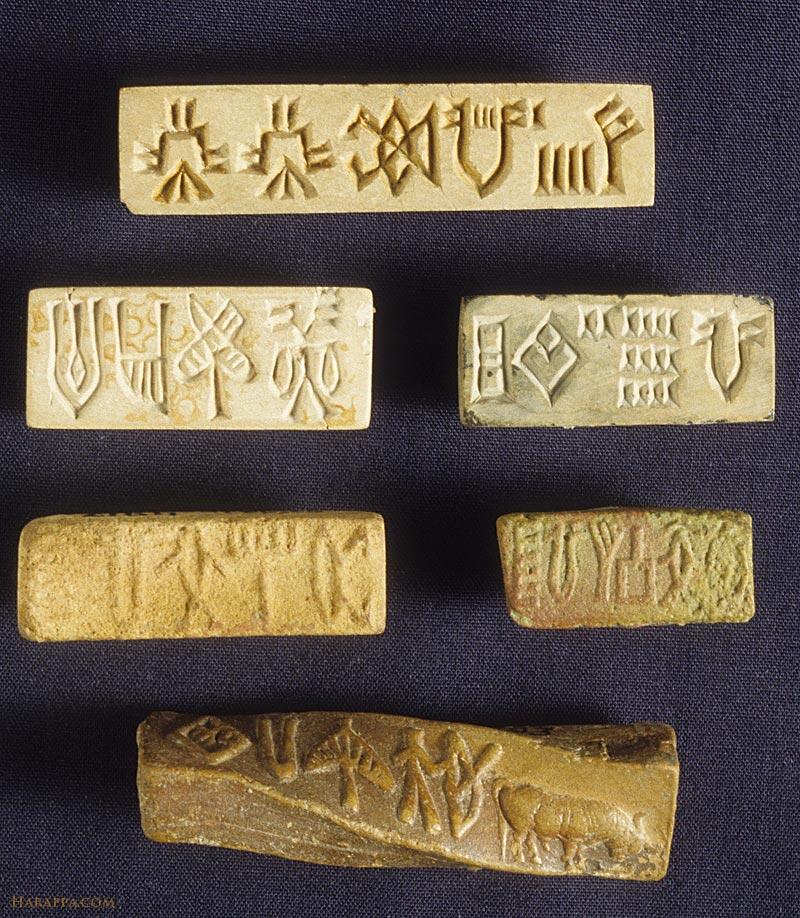 Seals and Sealing
Seals and Sealing
An Enigmatic Script
- Harappan seals typically have writing, possibly indicating the owner's name and title.
- Some scholars believe that the animal motifs on the seals conveyed meaning to those who couldn't read.
- The inscriptions on the seals are usually brief, with the longest containing approximately 26 signs.
- The Harappan script remains undeciphered, but it is not alphabetical due to the large number of signs (between 375 and 400).
- The script was likely written from right to left, as some seals show wider spacing on the right and cramped spacing on the left.
- Writing has been found on various objects such as seals, copper tools, jar rims, tablets, jewelry, bone rods, and even a signboard.
- It is possible that there was writing on perishable materials as well, suggesting that literacy may have been widespread.
Weights
- Exchanges were regulated using a system of weights made of chert.
- The weights were generally cubical in shape and had no markings.
- Lower denominations of weights were binary, while higher denominations followed the decimal system.
- Smaller weights were likely used for weighing jewellery and beads.
- Metal scale-pans have also been discovered.
Ancient Authority
- Complex decisions were made and implemented in Harappan society.
- The uniformity of Harappan artifacts, such as pottery, seals, weights, and bricks, indicates these complex decisions.
- Bricks, despite being produced in multiple centers, were of a uniform ratio throughout the region from Jammu to Gujarat.
- Settlements were strategically established in specific locations for various reasons.
- Labor was mobilized to make bricks and construct massive walls and platforms.
- The question asks who organized these activities.
Palaces and Kings
- Archaeological records do not provide clear information about centers of power or depictions of people in power.
- A large building at Mohenjodaro was called a palace, but no significant discoveries were associated with it.
- A stone statue known as the "priest-king" was found, but it is unclear if this person held political power.
- Some archaeologists believe Harappan society had no rulers and everyone had equal status.
- Others think there were multiple rulers, with Mohenjodaro and Harappa possibly having separate rulers.
- Some argue that there was a single state based on similarities in artifacts, planned settlements, and standardization.
- The theory of a single state seems the most plausible, as it is unlikely that communities could collectively make complex decisions.
The End of the Civilisation
- Around 1800 BCE, most of the Mature Harappan sites in regions like Cholistan were abandoned.
- There was a simultaneous population expansion into new settlements in Gujarat, Haryana, and western Uttar Pradesh.
- The remaining occupied Harappan sites after 1900 BCE showed a transformation in material culture, with the disappearance of distinctive artifacts, writing, long-distance trade, and craft specialization.
- Fewer materials were used to make fewer things, and construction techniques deteriorated.
- These changes are attributed to various factors such as climatic change, deforestation, excessive floods, and the shifting or drying up of rivers.
- However, these factors do not fully explain the collapse of the entire civilization.
- It is believed that the Harappan state came to an end, as evidenced by the disappearance of seals, script, distinctive beads and pottery, and the decline and abandonment of cities.
- New cities would not develop in the subcontinent for over a millennium.
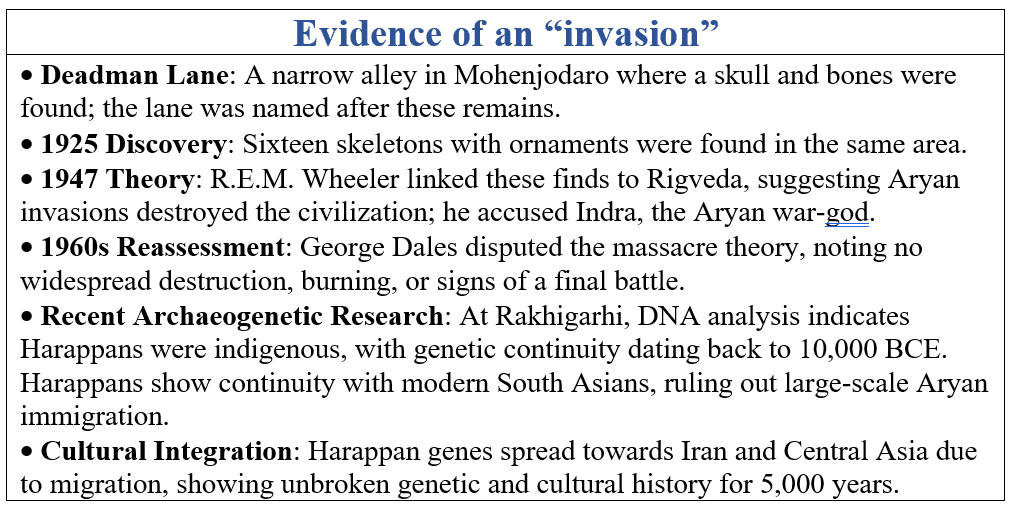
Discovering the Harappan Civilisation
- The Harappan civilization was "discovered" by archaeologists.
- The Harappan cities fell into ruin, and people forgot about them.
- Millennia later, people living in the area found strange artifacts that surfaced.
- These artifacts were found through floods, soil erosion, ploughing, or treasure hunting.
Cunningham's Confusion
- Cunningham, the first Director-General of the ASI, conducted archaeological excavations in the mid-nineteenth century.
- Initially, archaeologists relied on written texts and inscriptions for guidance in their investigations.
- Cunningham's main interest was in the Early Historic and later periods, using accounts left by Chinese Buddhist pilgrims to locate early settlements.
- He collected, documented, and translated inscriptions found during surveys.
- Cunningham tended to recover artifacts he believed had cultural value during excavations.

- Harappa, a site not mentioned by the Chinese pilgrims and not known as an Early Historic city, did not fit into Cunningham's investigation framework.
- Although Harappan artifacts were found during the nineteenth century, Cunningham did not realize their age.
- Cunningham received a Harappan seal but was unable to place it within his familiar time-frame as he believed Indian history began with the first cities in the Ganga valley.
A New Old Civilisation
- Seals were discovered at Harappa and Mohenjodaro by archaeologists in the early 20th century.
- These seals were found in layers that were much older than Early Historic levels, leading to the realization of their significance.
- Similar seals were also found at Mesopotamian sites, suggesting a contemporaneous civilization.
- John Marshall, Director-General of the ASI, announced the discovery of a new civilization in the Indus valley in 1924.
- Marshall's approach to excavation focused on everyday life patterns but disregarded the stratigraphy of the site, resulting in the loss of valuable contextual information.
New Techniques and Questions
- R.E.M. Wheeler became Director-General of the ASI in 1944 and rectified the problem of digging horizontally by following the stratigraphy of the mound.
- The frontiers of the Harappan civilization are not connected to present-day national boundaries.
- After the partition of the subcontinent, major Harappan sites are now in Pakistani territory, leading Indian archaeologists to search for sites in India.
- Surveys in Kutch, Punjab, and Haryana have revealed new Harappan settlements.
- Issues of cultural sequence and the logic of site locations are important to archaeologists.
- There has been growing international interest in Harappan archaeology since the 1980s.
- Modern scientific techniques, including surface exploration, are being used to analyze artifacts and recover remains.
- Joint efforts are being made by specialists from the subcontinent and abroad at Harappa and Mohenjodaro.
Problems of Piecing Together the Past
- The Harappan script does not provide much insight into the ancient civilization.
- Material evidence such as pottery, tools, ornaments, and household objects helps archaeologists reconstruct Harappan life.
- Organic materials like cloth, leather, wood, and reeds decompose easily, leaving behind stone, burnt clay, metal, etc.
- Only broken or useless objects were discarded, while valuable artifacts were either lost or hoarded.
- Intact finds are accidental rather than typical.
Classifying Finds
- Recovering artefacts is just the beginning of archaeology.
- Archaeologists classify their finds based on material and function.
- Classification based on material includes stone, clay, metal, bone, ivory, etc.
- Classification based on function involves determining if an artefact is a tool, ornament, or meant for ritual use.
- Resemblance to present-day objects and investigation of the artefact's context help determine its function.
- Indirect evidence, such as depictions in sculpture, may also be used to understand artefact function.
- Archaeologists develop frames of reference to understand artefacts, often relying on cultural sequences and comparisons with other findings.
Problems of Interpretation
- Archaeological interpretation is most problematic when it comes to reconstructing religious practices.
- Early archaeologists often misinterpreted certain objects, such as terracotta figurines of heavily jeweled women, as mother goddesses.
- Rare stone statuary of seated men, like the "priest-king," was also classified incorrectly.
- Structures like the Great Bath and fire altars were mistakenly assigned ritual significance.
- Attempts to reconstruct religious beliefs and practices through seals have led to misinterpretations.
- Some seals, depicting ritual scenes or plant motifs, were thought to indicate nature worship.
- Animals depicted on seals, like the one-horned animal, were often seen as mythical creatures.
- A seated figure in a yogic posture on some seals was mistakenly believed to be a depiction of "proto-Shiva."
- Many reconstructions of Harappan religion are based on assumptions and comparisons with later traditions.
- The depiction of "proto-Shiva" on seals does not match the description of Rudra in the Rigveda, leading to speculation about its meaning.
Timelines
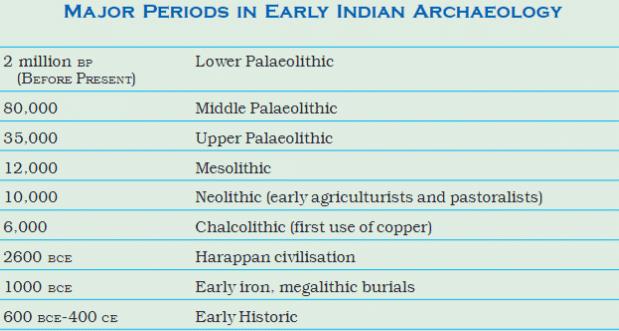 Timeline 1: Major Periods in Early Indian Archaeology
Timeline 1: Major Periods in Early Indian Archaeology
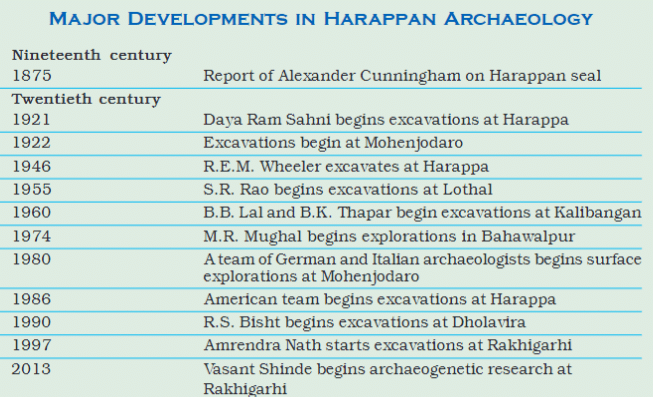 Timeline 2: Major Developments in Harappan Archaeology
Timeline 2: Major Developments in Harappan Archaeology
|
30 videos|274 docs|25 tests
|
FAQs on Bricks, Beads & Bones Class 12 History
| 1. What were the main subsistence strategies of the Harappan civilization? |  |
| 2. How was Mohenjodaro planned as an urban center? |  |
| 3. What evidence do we have of social differences in Harappan society? |  |
| 4. How did the Harappans procure materials for craft production? |  |
| 5. What factors contributed to the decline of the Harappan civilization? |  |

















